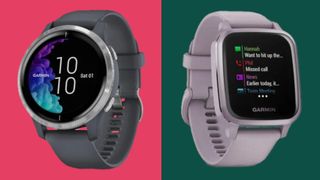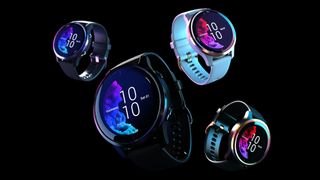
The Garmin Venu and Garmin Venu Sq are two of the best Garmin watches available today, and if you're looking for a smart wearable that will double as a great fitness tracker, they're both excellent options.
The 'Sq' is clearly short for 'square', but there are many other differences between the two watches that are worth knowing before you make your choice, so we've put together this guide to help you choose the right Venu for you.
Summary
Summary
The biggest difference between these two smartwatches isn't the shape, but the type and quality of the display. The Garmin Venu's AMOLED screen gives deeper blacks and a wider color gamut than the LCD display used by the Venu Sq.
The Venu's screen has a much higher resolution too, which means everything looks sharp and crisp. The Venu Sq's screen is perfectly functional, and certainly doesn't look bad, but the Venu is a joy to use.
The great screen comes at a price though, and the Venu is almost twice the price of the standard Venu Sq. Whether you can justify that extra expense will depend on your budget, and whether you frequently check your watch, or just leave it to quietly track your health stats in the background while you get on with other things.
Display and design
Display
- Venu has AMOLED display
- Venu Sq uses LCD
- Venu is higher resolution
The Garmin Venu has a circular display measuring 30.4mm in diameter, while the Venu Sq has a square screen that's 33.1mm diagonally (smaller than that of the Apple Watch 6, which measures 45.2mm).
Both watches have color displays, but the Venu has an AMOLED screen, whereas the Venu Sq uses LCD. AMOLED displays allow for more control over each pixel, and certain pixels to be switched off completely. This results in richer blacks and saving power if you opt for one of Garmin's darker watch faces. Viewing angles are better too, which is particularly handy for a display on your wrist.
Get daily insight, inspiration and deals in your inbox
Get the hottest deals available in your inbox plus news, reviews, opinion, analysis and more from the TechRadar team.

With an LCD display like that of the Venu Sq, the only source of light is the backlight, which means 'black' pixels aren't ever truly black, as they can't be disabled. The way colors are produced (by filtering and polarising that backlight) also means there's a smaller color gamut for an LCD screen than an AMOLED display.
Factor in the Garmin Venu's higher resolution (390 x 390 pixels, compared to 240 x 240), and you get a much clearer, crisper display that's capable of showing more information at once without a big increase in power usage.
The Venu also has an ambient light sensor, which allows its screen to adjust automatically depending on the lighting conditions for better visibility and improved power efficiency. The Venu Sq does not.
Design
- Garmin Venu is larger and heavier
- Venu has stainless steel case
- Venu Sq has aluminum case
The Garmin Venu has a round case that measures 43.2 x 43.2 x 12.4mm, and is made from reinforced plastic with a stainless steel bezel. The strap is silicone (black, light sand, or granite blue), but other options are available to buy through the Garmin store.
The Venu Sq's square case is slightly smaller, measuring 40.6 x 37.0 x 11.5mm. It's also made from reinforced polymer, but has an anodized aluminum bezel rather than stainless steel. This is lighter, but doesn't have quite the same premium look.

The Venu Sq's quick-release band is also made from silicone (shadow gray, white, orchid, or moss), and different straps are available to buy separately, including leather and woven designs.
Due to its smaller size and use of aluminum rather than steel, the Venu Sq is the lighter of the two watches, at 37.6g. The Garmin Venu tips the scales at 46.3g (roughly the same as the Apple Watch 6).
Both devices are rated to 5ATM, which means they can withstand water pressure at depths of up to 50m, and are suitable for showering, swimming and snorkelling (but not high-speed water sports or scuba diving).
Features
Smartwatch features
- Garmin Venu has Wi-Fi connectivity
- Standard model Venu Sq has no music storage
- Both support contactless payment
These two watches have broadly similar smartwatch features. Both have Bluetooth and ANT+ connectivity, allowing them to link to your phone, plus additional sensors like chest-strap heart rate monitors and footpods. However, the Venu also supports Wi-Fi, so you can connect it to your home network for quick, easy uploading of music and data.
The Venu has internal storage for 500 songs that you can listen to offline, but the standard Venu Sq only allows you to control music playback on your phone. There's a special music edition Venu Sq available that has offline music playback, but it's more expensive than the standard model.

The Venu and Venu Sq both allow you to make contactless purchases using Garmin Pay (provided your bank is one of those supported). You can also use either watch to find your phone (or vice versa), receive smartphone notifications, send a text response or reject a call with a text (if you have an Android phone), and download extra watch faces and apps through the Garmin Connect IQ store.
Fitness tracking features
- Very similar fitness tracking functions
- Venu has more sensors for outdoor navigation
The Venu and Venu Sq both have an optical heart rate monitor for measuring your heart rate throughout the day and during exercise. They also have a pulse oximeter than can measure changes in blood oxygen saturation while you sleep, and allows you to perform spot checks during the day.
Both have on-board GPS, supplemented by Galileo and GLONASS satellite navigation, but the Venu is a better choice for keen outdoor enthusiasts. It has a barometric altimeter, which detects changes on elevation based on pressure (great for hill training), plus a gyroscope, which measures orientation and direction.
In terms of activity tracking, there's little difference between the two. Both have a pedometer for tracking steps, and monitor distance travelled and calories burned throughout the day. Curiously, only the Venu measures floors climbed, which is a feature you'll find on even basic fitness trackers from the likes of Fitbit.

Both watches have activity profiles for strength, cardio and elliptical training, stair stepping, indoor rowing, yoga, pilates, and breathwork. There are downloadable training plans available through Garmin Connect to help you achieve specific goals as well.
If you're enjoy a round of golf, you'll be pleased to learn that both the Venu and Venu Sq are equipped with a selection of dedicated golfing tools, though only the Venu is capable of smart club tracking through the Approach system. That said, if golf is your main sport then you'll probably be better served by one of Garmin's dedicated GPS golf watches.
For swimmers, both watches offer stroke detection, a rest timer, time and distance alerts, and underwater heart rate measurement (something not all fitness trackers are capable of).
Price
Price
- Garmin Venu is almost twice the price of the Venu Sq
- Both are often cheaper at third-party retailers
The Garmin Venu is a more powerful device, with a much better display, so it's no surprise that it's also more expensive than the Venu Sq. In fact, it's almost twice the price.
At the time of writing (March 2021), the Garmin Venu costs $349.99 / £329.99 / AU$649 if you buy direct from Garmin. The Venu Sq, meanwhile, starts at $199.99 / £179.99 / AU$349.
Both watches can often be found more cheaply at third-party retailers though, and if you can wait a little while, you're likely to see some generous discounts around Black Friday and Cyber Monday.
- Take a look at our complete guide to the best running watches
Cat is the editor of TechRadar's sister site Advnture. She’s a UK Athletics qualified run leader, and in her spare time enjoys nothing more than lacing up her shoes and hitting the roads and trails (the muddier, the better)
Most Popular


